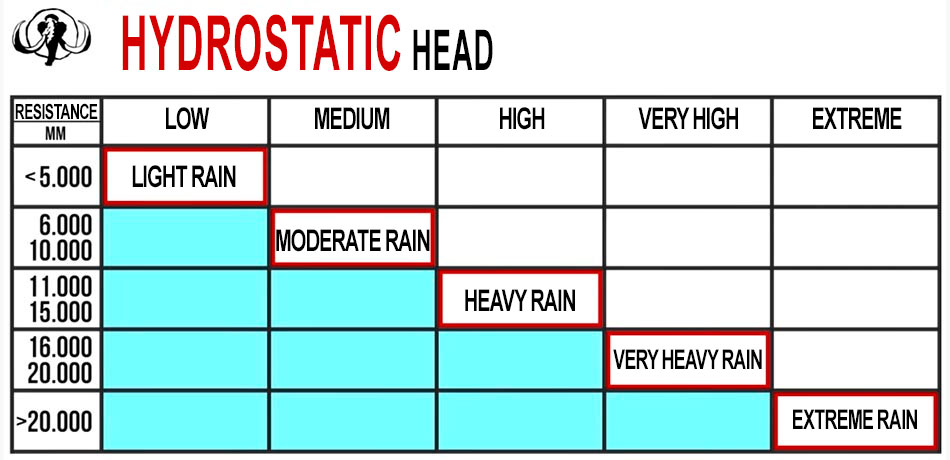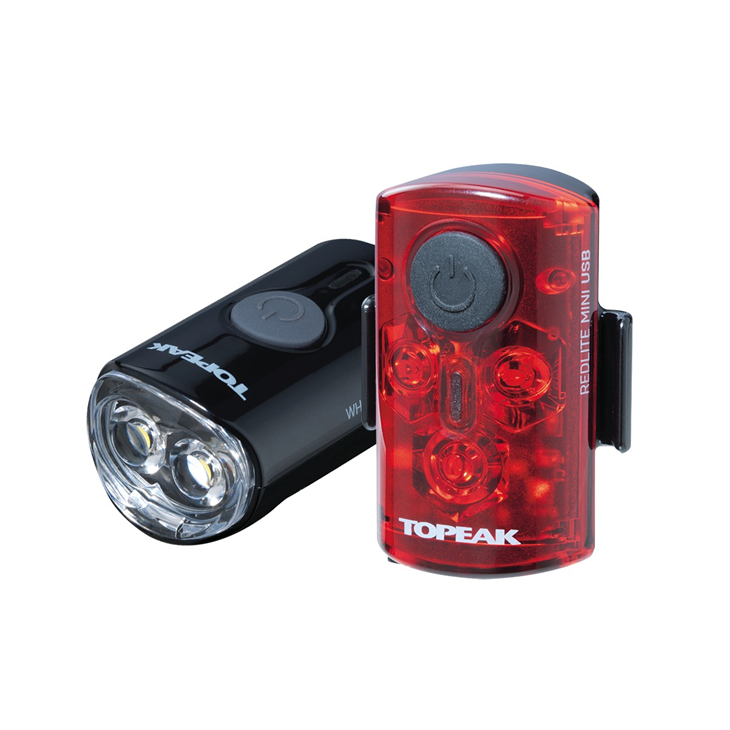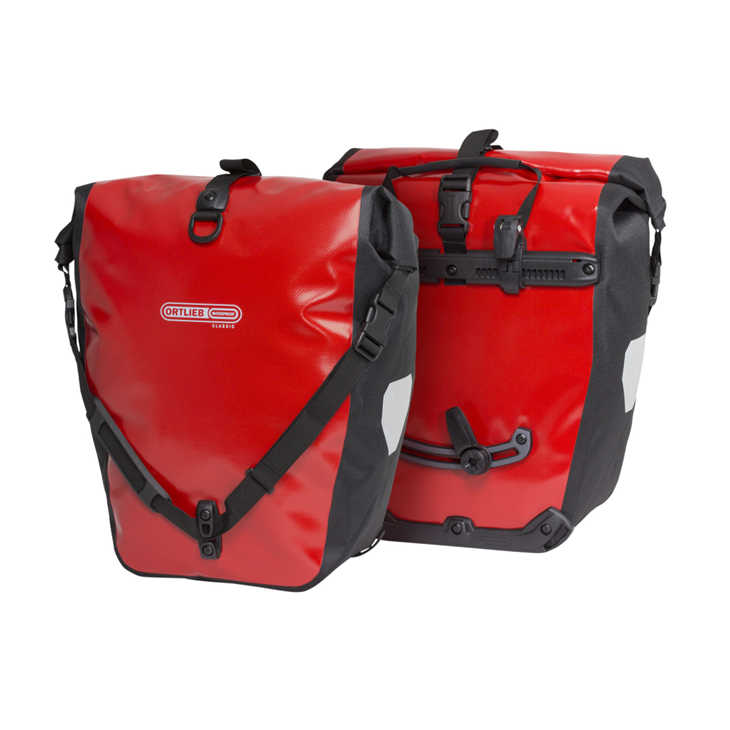When it comes to cycling in the rain, maintaining your body temperature effectively is crucial, and this is best achieved through a layering system. Here, we’ll explore the various types of shell layers and their effectiveness in shielding you from the rain. For more details on the complete layering system, you might want to read our article on “The Layering System for Cycling.â€
The primary requirement for any shell or outer layer is that it must be waterproof or water-resistant. The waterproofing capability is measured using the hydrostatic head (HH), which involves applying increasing pressure with a column of water against the fabric until it begins to seep through. Depending on the weather conditions and the duration of your exposure, you’ll need a certain level of hydrostatic head. We recommend selecting a minimum hydrostatic head of 5,000mm for light rain. The chart below can serve as a guide to help you choose the right gear.

Another vital factor to consider when picking your rainwear is breathability. This refers to the fabric's ability to release moisture, typically generated by sweat.
While waterproofing and breathability may seem contradictory, modern membranes and technical fabrics have managed to combine both properties in a single material, albeit at a higher cost. A cheap plastic rain jacket might suffice for a brief downpour, but for prolonged exposure to rain and intense physical activity, it will be nearly impossible to maintain your body temperature due to the buildup of sweat. On the opposite end of the spectrum, there’s the legendary Gore-Tex®, which offers a hydrostatic head of almost 30,000 mm and the highest level of breathability in waterproof garments.
*Tip:* Always keep a spare base-layer top and dry gloves in a waterproof bag within your backpack or tool kit. No matter how well you protect yourself, it's just a matter of time before you get soaked, especially in heavy or prolonged rain. A dry T-shirt and gloves can prevent hypothermia and allow you to finish your route comfortably.
It’s important to strike a balance between waterproofing capacity, breathability, and your budget based on the activity you're planning.
For your lower body, bib shorts with hydrophobic treatments and waterproof membranes in the most exposed areas, such as the lower back and knees, are ideal. For extreme conditions or extended periods outdoors, waterproof pants worn over the bib shorts, like the Endura Hummvee Waterproof Pant, are more suitable.

When it comes to gloves, they come in varying degrees of breathability and waterproofing. However, for long cycling trips in the rain, only neoprene gloves provide acceptable comfort and warmth, despite being non-breathable.
*Tip:* It’s wise to pack a pair of plastic gloves, similar to those found at gas stations, in your emergency kit alongside your tools and spares. In dire situations, placing them underneath wet gloves will insulate you from moisture, helping maintain your body temperature better than wearing wet gloves alone.
For keeping your feet warm and dry, options include specific boots with technical membranes, waterproof socks, and overshoes with varying levels of thermal protection and waterproofing, depending on the temperature.
*Tip:* Ensure that the area where the cleats attach to the shoe sole is sealed since it’s a common entry point for water. This can be done either by placing duct tape under the insole to cover the open area of the cleats or sealing external holes with silicone.
Don’t forget to pay extra attention to the visibility of your garments, as it decreases significantly in rainy conditions, especially when riding on busy roads.
For more information on choosing the right clothing, check out our article on “The Layering System for Cycling†and this video on “How to Choose Rainwear for Cycling.â€
### Helmets and Glasses
In rainy conditions, a waterproof helmet cover provides protection. Some models, like the Velotoze, feature a latex cover that fits most helmets and is quick to use and compact when not in use. An under-helmet with a technical membrane is particularly beneficial in colder temperatures.
Glasses are essential to shield your eyes from mud and water spray, which can make riding uncomfortable and dangerous. Many cyclists remove them because they fog up or the lenses get wet, but there are ways to minimize these issues.
To prevent fogging, use glasses without a tight, wrap-around fit and opt for those with anti-fog treatment and vent openings. An anti-fogging spray works wonders for all types of glasses.
Visors significantly reduce the number of raindrops reaching your glasses, making them highly recommended. If you’ve removed the visor from your helmet, reattach it when it rains. Alternatively, wear a cycling cap with a visor under your helmet.
For lens type, photochromic lenses adjust to changing light conditions and are ideal for unpredictable weather. However, if it’s overcast and low-light conditions persist throughout your ride, clear lenses with UV protection are the best choice.
### Rain Accessories
Besides clothing and personal gear, there are additional accessories designed to make cycling in the rain easier. Here are some of the most important ones.
#### Mudguards
This is a must-have accessory for cycling in rainy weather and is available for all types of bikes. They’re indispensable for urban use, though road and mountain bikers often overlook them. Mudguards protect against dirt and water spray from the wheels, which can be heavier than the rain itself.

#### Lights
Visibility is greatly reduced in the rain, so lights should be used even during the day, especially for urban and road use. Learn more about choosing the right cycling lights in our article.

#### Bags and Rain-Covers
A wide range of rain covers, panniers, and waterproof bags are available to protect your belongings during rides, especially for urban use, where items like computers, documents, and changes of clothes are often carried.

### Mechanics and Maintenance
Your bike also suffers from water and mud, so it’s advisable to take a few special measures regarding mechanics and maintenance:
- Lubricate the chain thoroughly with oil specifically designed for wet conditions.
- Clean and dry your bike thoroughly after use, paying special attention to the drivetrain, and reapply lubrication to prevent rust.
- Regularly check if your brakes and transmission components are worn.
- Fit tires designed for wet terrain, whether for mountain biking, road use, or urban commuting.
- Lower your usual tire pressure by about 10% to improve grip.
- Use specific mud tires on your mountain bike.
When riding in wet weather, take extra precautions:
- Increase the safety distance from other cyclists and vehicles.
- Reduce speed on bends.
- Brake gently and anticipate braking needs to account for longer stopping distances and reduced grip.
- Avoid braking over painted road markings, which become extremely slippery when wet, especially if covered in oil.
- Steer clear of large puddles, which might conceal hazards like potholes or cracks, and proceed cautiously if you must cross them.
- Stay away from oil stains to avoid skidding and potential damage to your bike’s braking system.
By following these tips, you'll find it much easier to continue cycling even in rainy weather. You’ll find all of the above products and professional advice at our Mammoth stores and online at [Mammoth Bikes](https://www.mammothbikes.com).
### Related Articles and Videos
- What is the Layering System for Cycling?
- How to Choose Cycling Rainwear
- Mudguards for MTB Topeak
- How to Choose Lights for Cycling
Off Grid System,Off Grid Solar System,Off Grid Power Systems,Off Grid Solar Power Systems
Jiangyin Haoxuan Technology Co., Ltd. , https://www.haoxuan-tech.com
